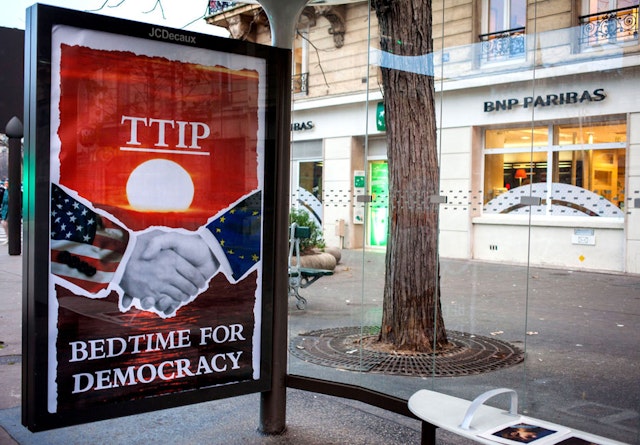Brandalism on subverting ad space in the name of creative civil disobedience
Since 2012, activist group Brandalism has been holding big companies to account with its own particular form of guerrilla activism, ‘subvertising’, as it looks to provoke a discussion on the legitimacy of outdoor advertising spaces. Here, it’s co-founder Peter Marcuse sits down with The Drum to discuss group tactics and whether Brandalism is really afraid of the big bad wolves.

Brandalism on subvertising: the art of creative civil disobedience
At some point in autumn 2020, Brandalism – a collective of activists trained in the art of hijacking advertising space – will orchestrate a takeover of out-of-home ads, replacing them with artwork calling out HSBC.
Why? Well, the group has accused the bank of “feigning solidarity with communities while investing heavily in fossil fuels and oppressing new security legislation in Hong Kong“. That and because surprise in combat is its favourite style of attack.
Since 2012, Brandalism has been challenging corporate power, greed and corruption around the world, parodying brand campaigns and subverting brand pledges to encourage passers-by to consider that what a brand says and what it does as two different things.
“The idea of going out and subverting billboards is almost as old as billboards themselves,“ says Peter Marcuse, one of Brandalism’s co-founders. “Banksy’s been doing it for years, but whether it’s just adding a word with a spray can or printing your own words and pasting it up, there’s a long-running creative art civil disobedience tradition.“
Marcuse says the group began as an art project back in 2012. “We were concerned about the dominance of corporate advertising messages in public spaces.“ He says the group wanted to provoke a discussion on the legitimacy of outdoor advertising spaces, which it feels the general public is forced to interact with.
The call to action asked artists to address the inter-related impacts of advertising on society, including body image, debt, cultural values, the environment and visual pollution. The project was given the name ’The 48 Sheet’, referencing large format billboards, and 36 sites across five UK cities were replaced with artworks calling out various brands, such as Nike, Lego and Westfield Shopping Centre .
“We don’t ask for permission to use the ad space. We take it over guerilla-style, using simple tools. We’ve produced a guide on how to access and claim these spaces for activists to use.“

Since then, Brandalism has staged a number of ad space revolts. In 2014, it returned to the streets to install 365 artworks in bus stop ad spaces across the UK. During the Paris Climate Conference in December 2015, the group made its way across the channel to work with over 1,000 Parisians and 80 artists to install 600 subvertisements calling out the role of corporate businesses in climate change.
And, just this week, it targeted motor advertising with #AdBrake, collaborating with artists, clean air campaigners and newly emerging ’Adblock’ groups to create poster artworks that parody car brands and car advertising.
“There’s an element of surprise that is needed for these actions – that’s the precaution that the group takes. Sometimes the artworks stay up for weeks if the outdoor advertising company fail to notice.“
But isn’t Brandalism afraid of the big, bad corporate wolves? “They are the big dogs and we are aware of it. But we’re quite happy to take them on. We take courage from previous campaigners who have taken on the big corporates, like the McLibel case in 1990.“
That English lawsuit that Marcuse references was filed by McDonald’s against two environmental activists, Helen Steel and David Morris, after they co-authored a six-page leaflet titled ’What’s wrong with McDonald’s: everything they don’t want you to know’. The pair distributed a few hundred copies across London, which caused the fast food chain to take them to court, culminating in a trial that lasted nearly 10 years and which the environmentalists eventually won.
“That turned into a huge PR disaster for McDonald’s because it was a classic case of David versus Goliath. In the end, McDonald’s used all this money taking the campaign into court and it just blew up in its face. So it’s quite encouraging for us.“

While it’s difficult to quantify the true impact of its takeovers, Marcuse says one measure of success is whether the images stick and resonate with the public. “Another is to take the idea of public legitimacy around acceptance of commercial advertising in public spaces and to push that debate further, showing that there are other ways we can use that pubic space that doesn’t involve filling every last nook and cranny with messaging about buying something.“
As Brandalism looks ahead, is there room for growth in its form of attack? “Art vandalism is just one tactic,“ Marcuse says. “To reach some of the bigger aims on pushing back on unsustainable consumerism and creating more public spaces for other priorities, we need other tactics that aren’t just guerilla takeovers. We need local resident groups to be fighting planning applications for new digital advertising, or for NGOs and think tanks to be producing reports and making recommendations to local councils.

“It definitely has advantages as a tactic, but in terms of creating long-term institutional change, we need other organisations to come into this space.“

